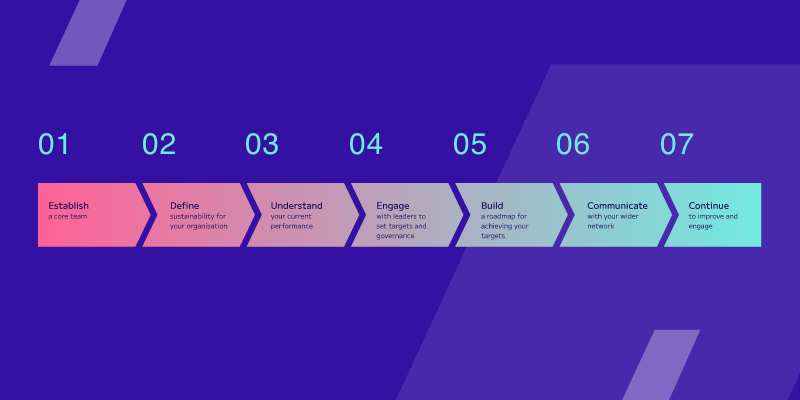A how-to guide for SMEs looking to start a sustainable journey
For SMEs, it’s often difficult to find the right information to kick-start your sustainability journey. The goal of this article is to present actionable steps for how your organisation can set, track and reach its sustainability targets, based on the collective experience of The PSC and JMAN Group Sustainability teams.
The JMAN Group and PSC Sustainability teams
For SMEs, it’s often difficult to find the right information to kick-start your sustainability journey. The goal of this article is to present actionable steps for how your organisation can set, track and reach its sustainability targets, based on the collective experience of The PSC and JMAN Group Sustainability teams.
We’ve compiled seven steps to getting off the ground.

Let’s get started…
Step 1: Establish a core sustainability team
A small group of action-focused individuals can act as the motor for your organisation’s sustainability efforts. They will understand, plan, implement and communicate the change required. Ensuring this group has the leadership, capacity and supporting processes to be successful is key.
Consider how the role of this group needs to be formalised to support change at the pace required e.g. through protected weekly or monthly time to focus on sustainability.
Step 2: Define what sustainability means for your organisation
Sustainability can mean different things to different people. Often three broad buckets are used: social, economic and environmental sustainability. The UN further segments these into 17 Sustainable Development Goals, which can be a good place to start.
Which of these does your organisation work towards now, and what contributing role does it play?
How could this change in future, aligned with your organisational vision?
Consider asking staff at all levels what’s important to them, for example through a questionnaire or short workshop.
Step 3: Understand your current sustainability performance
Depending on what sustainability means to your organisation, you might be looking to different parts of your business to understand your sustainability performance.
For most organisations, environmental impact as measured by carbon emissions is a good place to start. The GHG Protocol Corporate Accounting and Reporting Standard provides requirements and guidance for companies reporting on their carbon emissions, and a helpful calculation tool.
Emissions can be broadly divided into 3 “Scopes”, as shown in the graphic below from Green Business Bureau. For example, as management consultancies that deliver intellectual and digital products and rent office space, The PSC and JMAN have no scope 1 emissions. Our emissions impact sits mostly within scope 2, associated with our office buildings, and scope 3, associated with business travel. This is a guiding light for our emissions reduction strategy.

To understand your performance across social and economic sustainability you can use a wide variety of metrics. Examples include utilisation of pro-bono days and time spent supporting or training people from disadvantaged backgrounds to boost their employment opportunities. The National TOMs framework is a helpful resource for finding metrics for reporting on value in this way.
Step 4: Engage with leaders in your organisation to set SMART sustainability targets and set up governance that reports to the highest level
Through steps 1, 2 and 3 you will have developed an understanding of what’s important to your organisation, how it can be measured, and how you currently perform. Step 4 is the perfect time to set your organisation some clear and ambitious targets. The SMART model for setting targets is well-known and easy to use: the goals you set should be Specific, Measurable, Attainable, Realistic and Timebound.
It is crucial to get top-level leadership involved at this stage. Buy in and support from leadership will make achieving your targets a priority and help secure the resources needed to achieve them.
Your key design choices when setting targets are likely to include:
- Formal accreditations (like Science-Based Emissions Reduction Targets) vs internally designed and verified targets
- Formal reporting standards (e.g. as required from UK quoted companies) vs internally designed reporting and monitoring
- Aiming for carbon neutrality vs net zero
- Changes you want to achieve across the business vs changes you want to make in specific areas (e.g. can some parts of your business move faster than others?)
Answering these questions will help to set out a logical roadmap, with key enabling steps and quick wins at the start, and a longer-term focus on capability building.
Once you’ve done this thinking, the next steps become clear.
Step 5: Build a roadmap for how you plan to achieve these targets
It’s crucial to have a plan for how you intend to achieve your targets. The national Greener NHS Team has done this well for how the NHS can deliver on net zero – see their plan here and The PSC’s digest of the report here.
A great roadmap will include quick wins as well as longer term initiatives. Quick wins you might push for include:
- Switching to renewable energy providers
- Offsetting unavoidable carbon emissions through accredited schemes
- Switching to low-plastic office supplies
Longer-term initiatives for SMEs might include:
- Encouraging more sustainable commuting through a Cycle to Work Scheme
- Updating your business travel policy to incentivise more sustainable forms of transport
- Transferring to a sustainable pension plan
Step 6: Communicate with your network to encourage and co-develop sustainability policies and practices
Communicate the changes you’re making positively with clients, suppliers and partners, and be a critical friend in discussing their policies, practices and next steps. At The PSC and JMAN Group we’ve found our collaboration to share learnings and best practice crucial for the development of our sustainability initiatives, and also fun! You could also consider whether there is an association you could join and advocate within – for example, The PSC is an active member of the Management Consultancies Association’s Sustainability Working Group.
Step 7: Continue to improve and engage your colleagues in the importance of sustainability
Sustainability efforts need to be themselves sustained. Build on the initial momentum you’ve generated through both one-off events and day-to-day changes. This could be as small as having a space for sustainability in your team meetings or comms channels, or as large as holding an in-person event. Watch the footage of JMAN and The PSC’s COP26 event for example.
So, there it is! Everything you need to kick-start a sustainability journey that works for your organisation and helps save the planet.
If this has inspired you to make change, we’d love to be part of it – send us an email at hello@thepsc.co.uk or info@jmangroup.com or get in touch with one of our sustainability team members directly.
